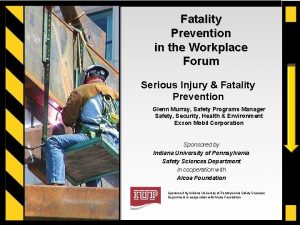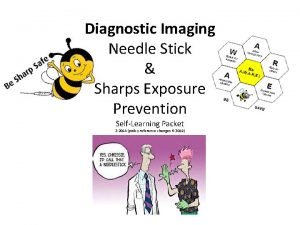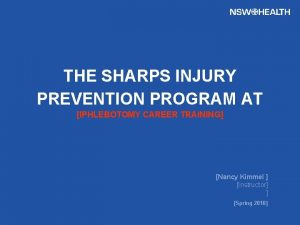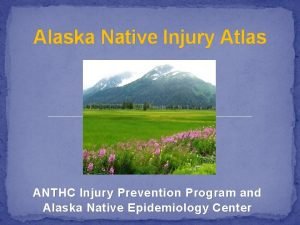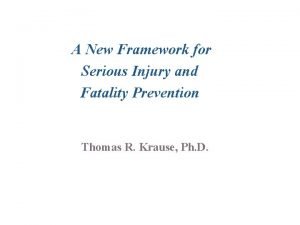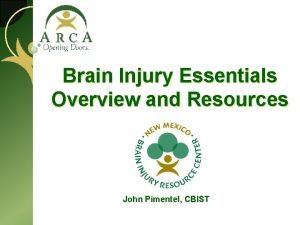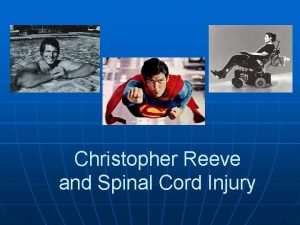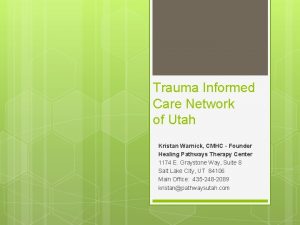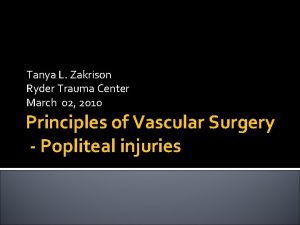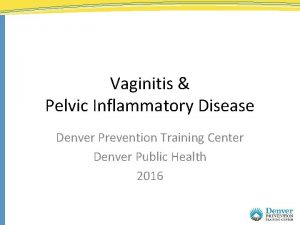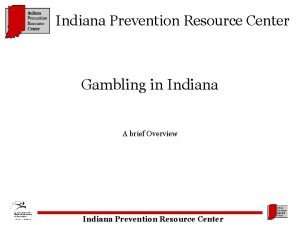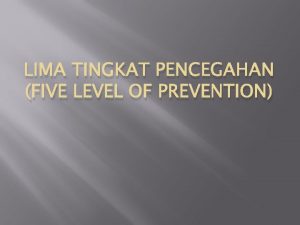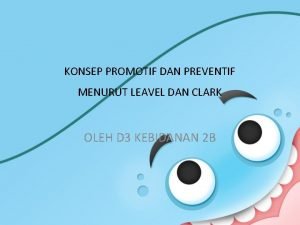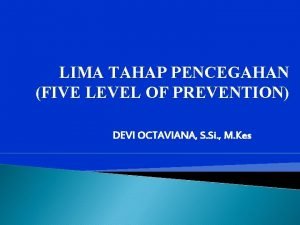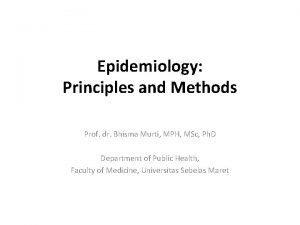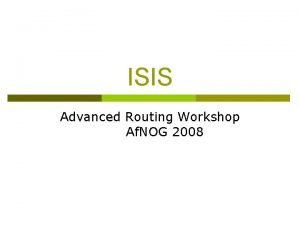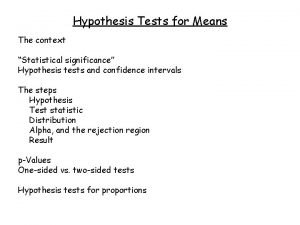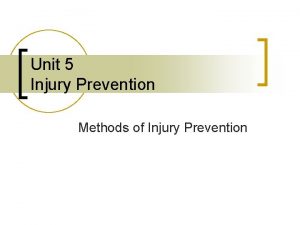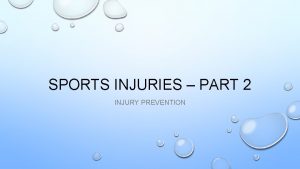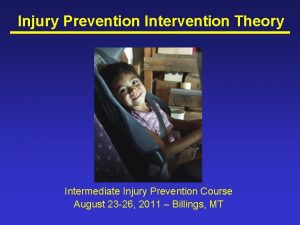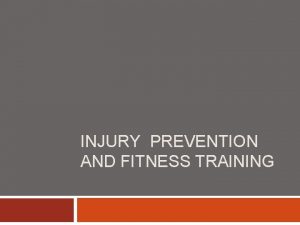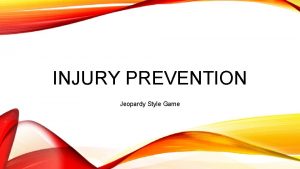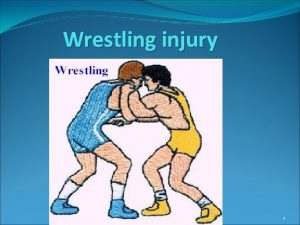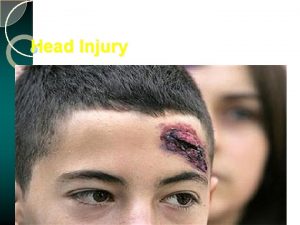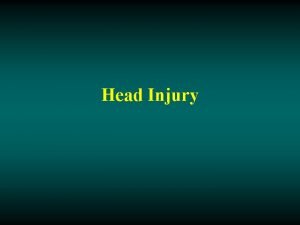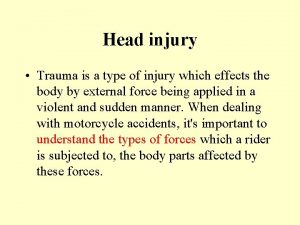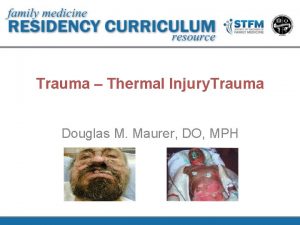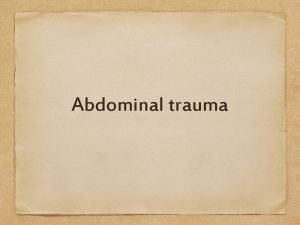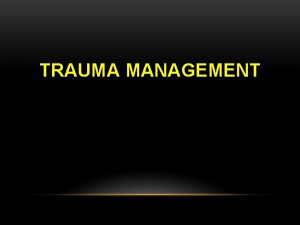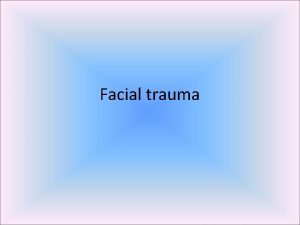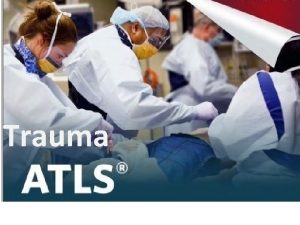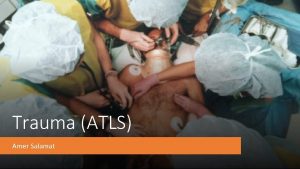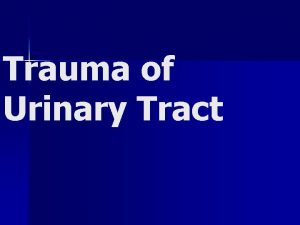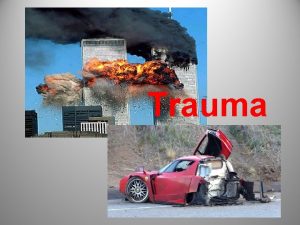Injury Prevention at a Trauma Level 1 Center




























- Slides: 28

Injury Prevention at a Trauma Level 1 Center Gloria Salazar, RN, MSN, MA, CP-CA SANE, LPC Manager, Trauma Education & Injury Prevention Division

“Injury Not An Accident” n n n n Predictable and Preventable High risk individuals High risk environments Third leading cause of death nationally Ages one to 44 years One person dies every three minutes Generates $406 billion lifetime costs (U. S. Center for Disease Control & Prevention 2010)

Injury Prevention Deaths Injury Deaths Compared to Other Leading Causes of Death for Persons Ages 1 -44, United States, 2007* ACS. 2008

Trauma a Disease Lacking Public Awareness n n n Trauma Level I Centers Identify specific injuries, patterns, risk factors 50% of patients who die do not reach a Trauma Center Injury prevention programs can reduce morbidity and mortality Reduce trauma recidivism

Distribution of Global Injury Mortality ACS, 2008

Injury Prevention Programs are Data Driven n n Trauma Registry Law-Enforcement n DSHS Safe Kids World Wide Emergency Nurses Association (ENA) Regional Registry n n Society Trauma Nurses (STN) n American Academy of Pediatrics (AAP) n Many others

Injury Prevention Strategies n n n Lessen morbidity & mortality Using principles of patient family centered care Age specific evidenced-based programs

Development of a Prevention Program n Define and focus n Effective n Systematic and organized approach n Appropriateness of steps (individualized) n Supported by data n Existence of many modules

Injury Prevention Collaboration Efforts n n n Local level: Inspections, presentations, events, classes State level: Safe Riders, Shattered Dream Program, CPS Week Regional level: Fall Prevention Program, Bicycle Helmet Safety National level: Safe Kids Coalition, n (ACS-COT, 2006)

Classification of Injury Prevention n Primary: elimination of injuries (stoplights, window guards, safety caps, car crash) Secondary: injury occurred but reduces severity injuries (seat belts, airbags, helmets) Tertiary: reducing the consequences of injury (trauma centers, rehabilitation)

Haddon’s Matrix a Conceptual Framework Haddon’s Factor-Phase Matrix for Motor Vehicle Crash Prevention PRE-EVENT POST-EVENT HOST Avoidance of alcohol use Use of safety belts Care delivered by bystander VEHICLE Antilock brakes Deployment of air bags Assessment of vehicle characteristic s that may have contributed to the event ENVIRONMENT Speed Limit Impactabsorbing barriers Access to trauma system

Example of Haddon's Matrix as Applied to Child Injury Prevention (child restraints) Phase Host Vehicle Physical Environment Social Environment Preevent Driver ability, driver training Event Human tolerances to Crash worthiness of crash forces, wearing the vehicle and CR of SB, correct CR (head extrusion) Postevent Crash victims general Petrol tanks designed Availability of effective Public support for health status to minimize likelihood and timely emergency trauma care and of post crash fire response rehabilitation Maintenance of brakes, vehicle inspection programs, installation of CR, CR checking programs Adequate roadway markings, correct installation of CR, right CR for child’s height and weight Attitudes to drink driving/speed/use of child restraints for every car trip Presence of fixed Enforcement of object near roadway, mandatory seatbelt or unsecured objects and child restraint use within the vehicle

The Four Es’ of Injury Prevention n n Education: provides public awareness and education Enforcement: Mandates behavioral changes Engineering: Advance technology as air bags, highway designs Economics: Incentives/non as financial support and insurance discounts

Trauma Centers: Developing an Injury Prevention Program n n Defining the problem: populationbased data. Defining the causes/risk factors: kind of injuries, where, when, why? Implement strategies: cost effective, simple, culturally sensitive, and group/age specific. Evaluate impact: successful change in behavior.

Internal Trauma Registry Data 2008 2009 2010 2011 Age 1 -6 years: 42 7 -12 years: 33 1 -6 years: 28 7 -12 years: 28 1 -6 years: 39 7 -12 years: 23 1 -6 years: 18 7 -12 years: 14 Gender M: 37 F: 38 M: 28 F: 28 M: 31 F: 31 M: 12 F: 20 Zip Code 79924 (NE) 79930 (C) 79925 (W) 79936 (E) 79930 (C) El Paso County 33 OUT OF 75 (44%) 27 OUT OF 56 (48%) 38 OUT OF 62 (61%) 16 OUT OF 32 (50%) Protective Device (EP) Rest: 16 (48%) Non-Rest: 12 Unkn: 5 Rest: 19 (70%) Non-Rest: 5 Unkn: 3 Rest: 22(58%) Non-Rest: 10 Unkn: 6 Rest: 10 (63%) Non-Rest. : 5 Unkn: 1 UMC Trauma Registry: Araceli Camacho

UMC Injury Prevention Programs n Motor Vehicle Crashes (MVA or MVC) n Water Safety Program n Fall Prevention Program n Helmet Safety Program n Many others

University Medical Center Car Seat Inspection Programs n Classes provided (English & Spanish) culturally sensitive n Programs prioritized by families needs n Target programs based on zip codes n Target high risk populations n Target community areas lacking resources

Year Classes Inspected Provided Destroyed 2008 0 156 76 0 2009 0 213 116 66 2010 0 253 137 69 2011 0 86 53 26 2012 0 56 23 0 # of Parents/Caregivers: 702 By: Martha Montellano 10/29/2012

Year Classes Inspected Provided Destroyed 2008 6 254 237 95 2009 34 1, 378 1, 169 566 2010 36 1, 013 903 535 2011 38 886 865 461 2012 52 958 968 512 # of Parents/Caregivers: 3, 051 By: Martha Montellano 10/29/2012

Year Classes Inspected Provided Destroyed 2008 6 410 313 95 2009 34 1, 591 1, 285 632 2010 36 1, 266 1, 040 604 2011 38 972 918 487 2012 52 1, 014 991 512 # of Parents/Caregivers: 3, 753 By: Martha Montellano 10/29/2012 Combined Inspection

Motor Vehicle Crashes (MVC) 2012 Safety Belt Use in Texas Front Seat-Estimated Safety Belt Use Driver--Estimated Safety Belt Use All Passenger Vehicles Passenger Cars Pickups 94. 04 94. 88 91. 71 94. 66 95. 56 92. 10 91. 05 91. 74 82. 11 Passenger-Estimated Safety Belt Use TXDOT, 2012

Fall Prevention Program n n n 8 million: ED visits suffer falls 1 in 3 Americans fall annually 65 yrs Leading cause of deaths Every 15 seconds: treated Every 27 minutes: dies n video

Tip Overs Year Total 2009 9 2010 3 (1) 2011 7 2012 5 (2)

Our Future n n n Injury Prevention is one of seven priorities by National Prevention Strategy. America’s Plan for Better Health and Wellness, released in 2011. 17 federal agencies to move the nation from a focus on sickness and injury to Prevention and Wellness.

Trauma Level I Centers “Those Who Fail to Plan; Plan to Fail” “That When Prevention Succeeds, Trauma is Conquered” ATS, 2009

References American Academy of Pediatrics (APA). 2011 State Legislation Report. Elk Grove, IL. American Academy of Pediatrics, 2011. American College of Surgeons Committee on Trauma. Advanced Trauma Life Support for Doctors (ATLS), Eight Edition, 2008. American College of Surgeons Committee On Trauma. Resources for Optimal Care of the Injured Patient 2006. American Trauma Society website. Injury Prevention Awareness Program: Facts and Figures, 2011. http: //www. amtrauma. org/injuryprevention/injuryprev. html. Access November 1, 2012.

References Bone NN, Gilchrist J. Dellinger AM, et al. CDC childhood Injury Report: Patterns of Unintentional Injuries Among 019 Year Olds in the U. S. , 2000 -2006. Atlanta, GA: U. S. Centers for Disease Control and Prevention, National Center for Injury Prevention and Control, 2008. Centers for Disease Control and Prevention (CDC): Medical expenditures attributable to injuries in the U. S. , 2000. MMWR Morb Mortal Weekly Rep 52: 04, 2004. Criddle, L. M. , Ph. D. Pediatric Care After Resuscitation, 2012. A Course for Nurses Across the Trauma System. The Laurelwood Group. Injury: Leading Cause of Death Among Persons 1 -44. U. S. Centers for Disease Control and Prevention. http: //www. cdc. gov/injury/overview/leadning_cod. Access November 1, 2012.

References Mc. Quillan, K. , Makic Flynn, M. B. , & Whalen, E. Trauma Nursing from Resuscitation Through Rehabilitation, fourth edition, 2009. Resources for Optimal Care of the Injured Patient, 2006. Wood Robert Johnson Foundation. Trust for America’s Health. The Facts Hurt: A State-By-State Injury Prevention Policy Report.
 Primary prevention secondary prevention tertiary prevention
Primary prevention secondary prevention tertiary prevention Intentional injury and unintentional injury
Intentional injury and unintentional injury Injuries first aid
Injuries first aid Workplace fatality prevention
Workplace fatality prevention Needle stick injury prevention images
Needle stick injury prevention images Back injury prevention quiz answers
Back injury prevention quiz answers Hand injury prevention
Hand injury prevention Sharps injury prevention program
Sharps injury prevention program Atlas injury prevention
Atlas injury prevention Serious injury and fatality prevention
Serious injury and fatality prevention New mexico brain injury resource center
New mexico brain injury resource center Christopher reeve spinal cord injury level
Christopher reeve spinal cord injury level Trauma awareness and treatment center utah
Trauma awareness and treatment center utah Nethercutt emergency center
Nethercutt emergency center Nethercutt emergency center
Nethercutt emergency center Ryder trauma center
Ryder trauma center Denver prevention training center
Denver prevention training center Indiana prevention resource center
Indiana prevention resource center Five prevention
Five prevention Tingkat pelayanan kesehatan menurut leavel dan clark
Tingkat pelayanan kesehatan menurut leavel dan clark Five level prevention
Five level prevention Epidemiology
Epidemiology Molecular level vs cellular level
Molecular level vs cellular level Isis protocol
Isis protocol How to interpret confidence intervals example
How to interpret confidence intervals example Isis level 1 vs level 2
Isis level 1 vs level 2 Significance level and confidence level
Significance level and confidence level Confidence level and significance level
Confidence level and significance level Bus garage repair dfd
Bus garage repair dfd



